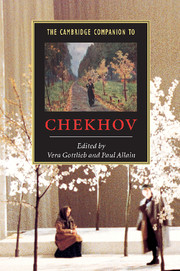Book contents
- Frontmatter
- Part 1 Chekhov in context
- Part 2 Chekhov in production
- 4 From Platonov to Piano
- 5 Chekhov's one-act plays and the full-length plays
- 6 Ivanov: the invention of a negative dramaturgy
- 7 The Seagull: an adaptation
- 8 Notes from a director: Uncle Vanya
- 9 Notes from a director: Three Sisters
- 10 The Cherry Orchard
- 11 Acting Chekhov: 'a friend to the actor'
- 12 The scenography of Chekhov
- 13 Chekhov on screen
- 14 Chekhov on the Russian stage
- 15 Directors' Chekhov
- Part 3 Chekhov the writer
- Appendix 1 Chekhov's works: primary sources from the Russian - Variations of English titles from the Russian
- Appendix 2 Selected stage productions
- Appendix 3 Selected screen versions
- Appendix 4 Illustrations
- Selected bibliography
- Index of Works by Checkov
- General Index
7 - The Seagull: an adaptation
from Part 2 - Chekhov in production
Published online by Cambridge University Press: 28 May 2006
- Frontmatter
- Part 1 Chekhov in context
- Part 2 Chekhov in production
- 4 From Platonov to Piano
- 5 Chekhov's one-act plays and the full-length plays
- 6 Ivanov: the invention of a negative dramaturgy
- 7 The Seagull: an adaptation
- 8 Notes from a director: Uncle Vanya
- 9 Notes from a director: Three Sisters
- 10 The Cherry Orchard
- 11 Acting Chekhov: 'a friend to the actor'
- 12 The scenography of Chekhov
- 13 Chekhov on screen
- 14 Chekhov on the Russian stage
- 15 Directors' Chekhov
- Part 3 Chekhov the writer
- Appendix 1 Chekhov's works: primary sources from the Russian - Variations of English titles from the Russian
- Appendix 2 Selected stage productions
- Appendix 3 Selected screen versions
- Appendix 4 Illustrations
- Selected bibliography
- Index of Works by Checkov
- General Index
Summary
'Writers who are considered immortal or just plain good and who intoxicate us have one very important trait in common: they are going somewhere and call you with them . . . The best of them are realistic and paint life as it is, but because every line is saturated with juice, with the sense of life, you feel, in addition to life as it is, life as it should be . . .
'Chekhov: letter to A.S. Suvorin, 25 November 1892.In 1981 I adapted The Seagull, resetting it on an Anglo-Irish estate in the West of Ireland, with the time of the action placed in the late nineteenth century.
The first reason why I did this was, quite simply, because I was asked to do so by Max Stafford-Clark, then artistic director of the Royal Court Theatre. Max felt, and I agreed with him, that some English language productions of Chekhov tended towards a very English gentility where the socially specific Chekhov tended to be lost in polite vagueness. He believed that an Anglo-Irish setting would provide a specificity, at once removed from, and at the same time comprehensible to, an English audience. He also felt that an Irish setting would more easily allow the rawness of passion of the original to emerge, the kind of semi-farcical hysteria, which Chekhov uses in the scenes between Arkadina, Treplyov and Trigorin in Act Three, for example: a kind of rough theatricality somewhat removed from polite English comedy but common enough in the Irish comic tradition.
- Type
- Chapter
- Information
- The Cambridge Companion to Chekhov , pp. 80 - 90Publisher: Cambridge University PressPrint publication year: 2000
- 1
- Cited by



